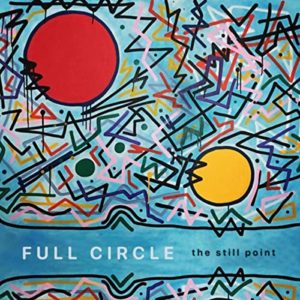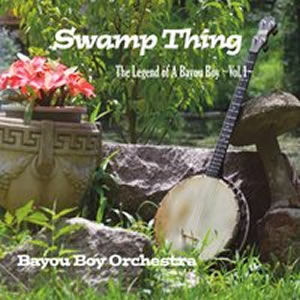 The Still Point instrumental trio, augmented by a horn section, deliver plenty of exciting, involving numbers on their third album Full Circle. Hayes Cumming’s electric guitar phrasing finds him moving melodies around with rockin’ edge and jazzy freedom. While Cummings and the rhythm section of bass player Max Liebman and drummer Alexander Dillon play a continuous flow of music dotted by artistic bright spots along the way, they also adorn their music with a two piece horn section that adds swells and melodic phrases around rumbling bass lines, drum fills, and incendiary guitar.
The Still Point instrumental trio, augmented by a horn section, deliver plenty of exciting, involving numbers on their third album Full Circle. Hayes Cumming’s electric guitar phrasing finds him moving melodies around with rockin’ edge and jazzy freedom. While Cummings and the rhythm section of bass player Max Liebman and drummer Alexander Dillon play a continuous flow of music dotted by artistic bright spots along the way, they also adorn their music with a two piece horn section that adds swells and melodic phrases around rumbling bass lines, drum fills, and incendiary guitar.
Opening cut “The Rooster” finds Cummings revving up his electric six string with an interval of edgy notes, his guitar strutting like a rooster. Trumpeter Billy Jewell shadows him with a wider interval until both guitar and horn are dancing around a slow groove, guitar giving off sparks with crackling notes that move faster than a dancer’s feet. The trumpet gives a vibrant feel around the guitar, becoming as thin as a trumpet can be played. It is the individual instrumental flourishes as well as the interplay between both superb musicians that keep this entertaining, involving, and impressive.
“Whose Blues” takes the outfit down low, down tempo, easy going. The pace lets the a tenor saxophone smolder slowly, its phrase dancing around a light groove with continuous phrasing, phrasing that finesses the spaces left open by the rhythm section. The rhythm boys play lightly around the horn, a well placed fill here, an understated bass there. Cummings comes to the fore with a fanciful phrase that swaggers around every other instrument. Everything in this song comes together coolly, showing that with the right touches and the right amount of everything, this outfit can really create a vibe and hang out in it by feeling each other’s place and staying away from it until it’s the next guys turn to grease the vibe.
“Landspeed” too cruises at a mellow pace. While taking things slow, there’s plenty of Cummings guitar phrasing, releasing intervals of notes that dance like gypsies around a fire. Those notes cast their shadows over plenty of speedy drum fills and nudges from the bass guitar. It is the contrast between light melodic notes and darker twists from the rhythm section that opens this one up for further appreciation of a band that can set a mood.
“Cool Water,” strangely enough, reminds of the guitar atmosphere at the intro to The Door’s epic “The End.” Soon, the saxophone chimes in with a mournful melody, a pace and a vibe that makes one picture mourners walking slowly into a chapel. A vibrant trumpet line soon enters the proceedings to bring levity and reflection to what is part celebratory and part sadness. This number’s success is in how it combines a cool jazz vibe with the more assertive strides of rock music.
Snappy rhythmic affair, “Big Dig,” allows this band to show their groove magic. Not only do the bass and drums provide a motivating force, the horns follow it with shots that emphasize. It only follows that each instrumentalist gets a chance to strut. Cumming’s lead guitar climbs ever higher in expression and pitch, trailed by the horns, following him into the stratosphere. This tune holds our ears by becoming a mountainous growth of sounds, constructing it ever so cleverly with their talents as they go. The McKay tenor sax line spirals with a strength and vibe found in the hard bop jazz records on the 1950s. Perfect.
Cool jazz oozes out of track six, “Forgotten Standards.” Long elegant guitar phrases soothe the ear and soul. Their mellow octave vibe stretches out a bit before taking off in flintier, more accented notes. Shadowed by Liebman’s subtle upright bass notes, the two instruments perform an elegant dance of big notes and low. As Liebman mimics the Cummings patterns, the number takes on greater complexity. It is also fun to listen to how the two players accommodate each other.
“Up A Creek” continues the easy slide into light, cool jazz. A thin, mischievous sax line hints at mystery as a wiry, free form guitar sputters beautifully out of control. The vibe here is part 1960s hippie and part 1950s beatnik. Swaying motion from both instruments and their climactic drum support conjure all kinds of images. It’s the explosion of good instrumentation that makes one want to hit the repeat button to notice how the players trigger each other.
Moving along gracefully, motivated by light touches from each instrumentalist, “Something Else” tickles the ear with its devotion to self-restraint. Even when its tempo moves into racing speed, each note is gently finessed. Keeping the notes gently in their place allows this outfit to show how well they can manipulate notes to achieve effects, vibes, atmosphere.
“Second Thought” lets trumpet man Jewell blow a shiny, vibrant line that rises up beautifully from an understated groove. That trumpet phrase combines beauty with art, showing a true feel for soul soothing mood. Soon, McKay’s tenor sax dances around the vibrancy with a thinner, smokier but no less pretty line. The tune’s inventive use of horn, making them dance around each other with sensitivity and power is particularly clever.
Close out track “Wait” is a mellow, bluesy, dreamy piece. Light brushes of horn augmented by subtle electric guitar picking float like a cloud. The melodies travel over a subtle rhythm section, barely perceptible fills and nudges that carry it all with appropriate tastefulness.
The Still Point with their Full Circle album, recorded live at Record CD Boston, have certainly done a fine job with this work of jazzy rock or rockin’ jazz. Sophistication and edge combine to offer several choice cuts that will find a welcome home in many CD players.

